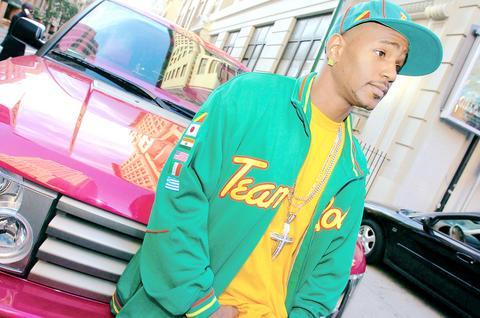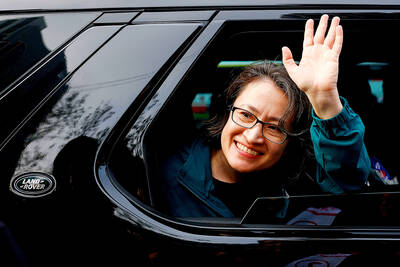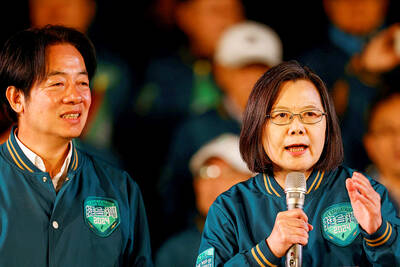In a gated condominium community in Fort Lee, New Jersey, the dense shrubbery suggests a botanical garden more than a residential one. A lantern at the foot of each house's staircase is illuminated before sundown, and there is a late-model sport utility vehicle in nearly every drive. But there is only one hot-pink Range Rover. That is how you can tell the house of Cameron Giles.
For the better part of two years, pink has been the dominant color in the life of Giles, a rapper who performs as Cam'ron. "When I did pink, I did it so I wouldn't be dressing like everybody else," he said. The color seemed guaranteed to set him apart in the world of hip-hop, where men's style tends to conform to notions of hypermasculinity.

PHOTO: NY TIMES
When Giles first wore pink, in the summer of 2002 in a video for Hey Ma and at music industry events, he thought he had found a one-of-a-kind look.
A funny thing happened, though. Not long after Hey Ma began climbing the Top-40 charts, pink began to show up in the wardrobes of other urban young men. At last year's Puerto Rican Day Parade, pink clothing on men offered a counterpoint to the event's macho posturing.
Other hip-hop figures like P. Diddy and Russell Simmons, and the R & B singer R. Kelly, wore pink.
"Cam was the first hard-core rapper to rock pink," said Emil Wilbekin, a former editor in chief of Vibe magazine, who is now an executive at the fashion house Marc Ecko. "What was interesting was how quickly the streets caught on."
Giles himself, however, said he is over the look. He wants to move on. "Me, personally, I haven't worn pink in about four or five months, just for the simple fact that everybody's wearing pink," he said the other day.
He plans to adopt a new color, raising the possibility that he might start a new fad. The sartorial decisions of hip-hop stars strongly affect clothing trends. The fortunes of companies like Tommy Hilfiger and Timberland rose after they were embraced by rap stars, and labels like Sean John and Ecko stake everything on anticipating the urban market.
Giles is cagey about his next big color, hoping to find a way to reap financial gains this time. That might include starting a clothing line of his own. "I'm not going to tell anybody until I patent it," he said of his post-pink color.
"If this many people enjoy my style, and other people want to be fly in the same type of fashion I'm being fly in, then I might as well benefit off it."
It is possible, though, to make an educated guess about Giles's secret. His next album, due in December, is called Purple Haze. A limited-edition cap he designed last summer for the New Era Cap Company featured metallic purple accents. One of his rap crews is called Purple City, a nod to a neighborhood in Harlem and a type of marijuana sold there.
And in April, Giles, in partnership with a company called Harbrew Imports, introduced Sizzurp, a "purple punch liqueur" named for a codeine-laced concoction popular in the South.
Giles, 28, was born and raised in Harlem, and he found fashion at an early age. "Just growing up in Harlem, it didn't matter what you had to do to get fresh, you would do it," he said. "I recall the Skate Key in the Bronx," he continued, referring to a roller disco popular in the 1980s. "You maybe had to go steal your mom's earrings and go pawn them, borrow US$10 from four or five people, but when you got there, it looked like you had $8,000 in your pocket."
In the mid-1990s, he joined his first rap crew, Children of the Corn. Membership required clothes as impressive as one's rhymes -- Sergio Tacchini track suits in particular. "I had to make sure I was on point" around the other rappers, Giles recalled. "They used to go all the way downtown to look for stuff nobody would have. Growing up with them was a privilege."
Giles found stardom as a soloist in 1998 when his album Confessions of Fire went gold. A follow-up, Come Home With Me, in 2002, went platinum and reached No. 2 on the Billboard charts.
Although he has not had the mainstream popularity of P. Diddy or Jay-Z, he is Harlem's most prominent rapper, famous for a sort of avant-garde gangster rap that is dense with polysyllabic rhyme schemes and fashion references.
Giles credits his stylist, Monica Morrow, with introducing him to pink. "I came up with it," Morrow said, "but him putting it on made everyone fall in love with it."

The year was 1991. A Toyota Land Cruiser set out on a 67km journey up the Junda Forest Road (郡大林道) toward an old loggers’ camp, at which point the hikers inside would get out and begin their ascent of Jade Mountain (玉山). Little did they know, they would be the last group of hikers to ever enjoy this shortcut into the mountains. An approaching typhoon soon wiped out the road behind them, trapping the vehicle on the mountain and forever changing the approach to Jade Mountain. THE CONTEMPORARY ROUTE Nowadays, the approach to Jade Mountain from the north side takes an

Relations between Taiwan and the Czech Republic have flourished in recent years. However, not everyone is pleased about the growing friendship between the two countries. Last month, an incident involving a Chinese diplomat tailing the car of vice president-elect Hsiao Bi-khim (蕭美琴) in Prague, drew public attention to the People’s Republic of China’s (PRC) operations to undermine Taiwan overseas. The trip was not Hsiao’s first visit to the Central European country. It was meant to be low-key, a chance to meet with local academics and politicians, until her police escort noticed a car was tailing her through the Czech capital. The

Last week Joseph Nye, the well-known China scholar, wrote on the Australian Strategic Policy Institute’s website about how war over Taiwan might be averted. He noted that years ago he was on a team that met with then-president Chen Shui-bian (陳水扁), “whose previous ‘unofficial’ visit to the US had caused a crisis in which China fired missiles into the sea and the US deployed carriers off the coast of Taiwan.” Yes, that’s right, mighty Chen caused that crisis all by himself. Neither the US nor the People’s Republic of China (PRC) exercised any agency. Nye then nostalgically invoked the comical specter

April 15 to April 21 Yang Kui (楊逵) was horrified as he drove past trucks, oxcarts and trolleys loaded with coffins on his way to Tuntzechiao (屯子腳), which he heard had been completely destroyed. The friend he came to check on was safe, but most residents were suffering in the town hit the hardest by the 7.1-magnitude Hsinchu-Taichung Earthquake on April 21, 1935. It remains the deadliest in Taiwan’s recorded history, claiming around 3,300 lives and injuring nearly 12,000. The disaster completely flattened roughly 18,000 houses and damaged countless more. The social activist and